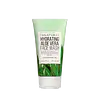What's inside
What's inside
 Key Ingredients
Key Ingredients

 Benefits
Benefits

 Concerns
Concerns

 Ingredients Side-by-side
Ingredients Side-by-side

Water
Skin ConditioningDisodium EDTA
Carbomer
Emulsion StabilisingXanthan Gum
EmulsifyingDecyl Glucoside
CleansingPropylene Glycol
HumectantCetyl Alcohol
EmollientCetearyl Alcohol
EmollientGlyceryl Stearate
EmollientPEG-100 Stearate
Aloe Barbadensis Leaf Extract
EmollientGlycerin
HumectantButylene Glycol
HumectantSodium Citrate
BufferingCitric Acid
BufferingCeramide NP
Skin ConditioningCeramide AP
Skin ConditioningCeramide EOP
Skin ConditioningSodium Hyaluronate
HumectantSodium Glutamate
MaskingZinc PCA
HumectantTriticum Vulgare Germ Oil
EmollientTriethanolamine
BufferingPhenoxyethanol
PreservativeCaprylyl Glycol
EmollientWater, Disodium EDTA, Carbomer, Xanthan Gum, Decyl Glucoside, Propylene Glycol, Cetyl Alcohol, Cetearyl Alcohol, Glyceryl Stearate, PEG-100 Stearate, Aloe Barbadensis Leaf Extract, Glycerin, Butylene Glycol, Sodium Citrate, Citric Acid, Ceramide NP, Ceramide AP, Ceramide EOP, Sodium Hyaluronate, Sodium Glutamate, Zinc PCA, Triticum Vulgare Germ Oil, Triethanolamine, Phenoxyethanol, Caprylyl Glycol
Water
Skin ConditioningCocamidopropyl Betaine
CleansingSodium Cocoyl Isethionate
CleansingDecyl Glucoside
CleansingGlycerin
HumectantPolysorbate 80
EmulsifyingSodium Lauroyl Sarcosinate
CleansingPyrus Malus Fruit Extract
Skin ConditioningSodium PCA
HumectantEthylhexylglycerin
Skin ConditioningPhenoxyethanol
PreservativeHydroxypropyl Methylcellulose
Emulsion StabilisingPEG-150 Pentaerythrityl Tetrastearate
EmulsifyingParfum
MaskingPanthenol
Skin ConditioningSodium Hyaluronate
HumectantTetrasodium EDTA
Aloe Barbadensis Leaf Powder
Skin ConditioningWater, Cocamidopropyl Betaine, Sodium Cocoyl Isethionate, Decyl Glucoside, Glycerin, Polysorbate 80, Sodium Lauroyl Sarcosinate, Pyrus Malus Fruit Extract, Sodium PCA, Ethylhexylglycerin, Phenoxyethanol, Hydroxypropyl Methylcellulose, PEG-150 Pentaerythrityl Tetrastearate, Parfum, Panthenol, Sodium Hyaluronate, Tetrasodium EDTA, Aloe Barbadensis Leaf Powder
 Reviews
Reviews

Ingredients Explained
These ingredients are found in both products.
Ingredients higher up in an ingredient list are typically present in a larger amount.
Decyl Glucoside is a glucose-based surfactant and emulsion stabilizer. It is created by reacting glucose with the fatty acids from plants.
Surfactants help clean the skin by trapping oil, sebum, and dirt to be washed away. As an emulsion stabilizer, it stabilizes the ingredients in a product by preventing them from separating.
This ingredient is biodegradable and non-toxic. This ingredient is commonly found in baby shampoos.
Decyl Glucoside is sometimes used to stabilize the UV filter Tinosorb.
Learn more about Decyl GlucosideGlycerin is already naturally found in your skin. It helps moisturize and protect your skin.
A study from 2016 found glycerin to be more effective as a humectant than AHAs and hyaluronic acid.
As a humectant, it helps the skin stay hydrated by pulling moisture to your skin. The low molecular weight of glycerin allows it to pull moisture into the deeper layers of your skin.
Hydrated skin improves your skin barrier; Your skin barrier helps protect against irritants and bacteria.
Glycerin has also been found to have antimicrobial and antiviral properties. Due to these properties, glycerin is often used in wound and burn treatments.
In cosmetics, glycerin is usually derived from plants such as soybean or palm. However, it can also be sourced from animals, such as tallow or animal fat.
This ingredient is organic, colorless, odorless, and non-toxic.
Glycerin is the name for this ingredient in American English. British English uses Glycerol/Glycerine.
Learn more about GlycerinPhenoxyethanol is a preservative that has germicide, antimicrobial, and aromatic properties. Studies show that phenoxyethanol can prevent microbial growth. By itself, it has a scent that is similar to that of a rose.
It's often used in formulations along with Caprylyl Glycol to preserve the shelf life of products.
Sodium Hyaluronate is hyaluronic acid's salt form. It is commonly derived from the sodium salt of hyaluronic acid.
Like hyaluronic acid, it is great at holding water and acts as a humectant. This makes it a great skin hydrating ingredient.
Sodium Hyaluronate is naturally occurring in our bodies and is mostly found in eye fluid and joints.
These are some other common types of Hyaluronic Acid:
Learn more about Sodium HyaluronateWater. It's the most common cosmetic ingredient of all. You'll usually see it at the top of ingredient lists, meaning that it makes up the largest part of the product.
So why is it so popular? Water most often acts as a solvent - this means that it helps dissolve other ingredients into the formulation.
You'll also recognize water as that liquid we all need to stay alive. If you see this, drink a glass of water. Stay hydrated!
Learn more about Water